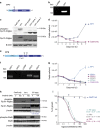Generation of the Fip1l1-Pdgfra fusion gene using CRISPR/Cas genome editing
- PMID: 27021554
- PMCID: PMC5240015
- DOI: 10.1038/leu.2016.62
Generation of the Fip1l1-Pdgfra fusion gene using CRISPR/Cas genome editing
Figures


References
-
- Cools J, DeAngelo DJ, Gotlib J, Stover EH, Legare RD, Cortes J et al. A tyrosine kinase created by fusion of the PDGFRA and FIP1L1 genes as a therapeutic target of imatinib in idiopathic hypereosinophilic syndrome. N Engl J Med 2003; 348: 1201–1214. - PubMed
-
- Tefferi A, Vardiman JW. Classification and diagnosis of myeloproliferative neoplasms: the 2008 World Health Organization criteria and point-of-care diagnostic algorithms. Leukemia 2008; 22: 14–22. - PubMed
-
- Jovanovic JV, Score J, Waghorn K, Cilloni D, Gottardi E, Metzgeroth G et al. Low-dose imatinib mesylate leads to rapid induction of major molecular responses and achievement of complete molecular remission in FIP1L1-PDGFRA-positive chronic eosinophilic leukemia. Blood 2007; 109: 4635–4640. - PubMed
-
- Lierman E, Michaux L, Beullens E, Pierre P, Marynen P, Cools J et al. FIP1L1-PDGFRalpha D842V, a novel panresistant mutant, emerging after treatment of FIP1L1-PDGFRalpha T674I eosinophilic leukemia with single agent sorafenib. Leukemia 2009; 23: 845–851. - PubMed
-
- von Bubnoff N, Sandherr M, Schlimok G, Andreesen R, Peschel C, Duyster J. Myeloid blast crisis evolving during imatinib treatment of an FIP1L1-PDGFR alpha-positive chronic myeloproliferative disease with prominent eosinophilia. Leukemia 2005; 19: 286–287. - PubMed
Publication types
MeSH terms
Substances
LinkOut - more resources
Full Text Sources
Other Literature Sources
Miscellaneous

